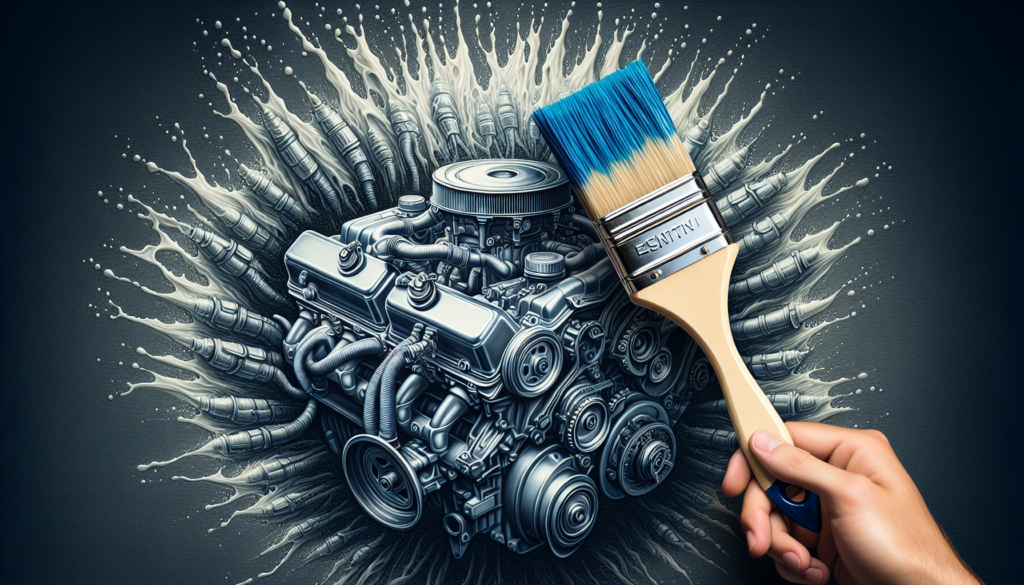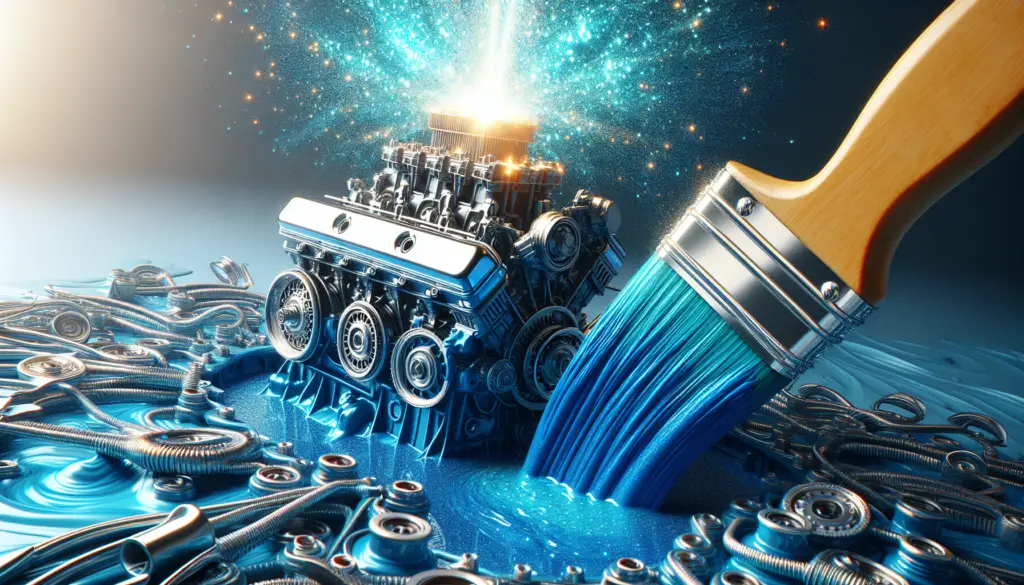So you finally got that boat you’ve always dreamed of, but now you want to give it a personal touch? Look no further! In this DIY guide to painting your boat engine, we will take you through an easy step-by-step process to transform your engine into a work of art. Whether you’re looking to spruce up your boat for a weekend getaway or impress fellow sailors at the marina, this guide has got you covered. Grab your brushes and let’s dive into the world of boat engine painting!
Preparation
Gather the Necessary Supplies
Before you begin painting your boat engine, it is important to gather all the necessary supplies. You will need paint, primer, masking tape, a brush or roller, a drop cloth or plastic sheeting, cleaning solution, and a soft cloth. It is essential to use marine-grade paints and primers that are specifically designed for use in water environments. These specialized products will ensure durability and longevity of the paint job.
Safety Precautions
Safety should always be a top priority when undertaking any DIY project. When painting your boat engine, be sure to take the necessary safety precautions. Wear protective clothing, including gloves and safety goggles, to safeguard yourself from paint fumes and potential splatters. Additionally, ensure that you are working in a well-ventilated area to minimize exposure to harmful fumes. Finally, be aware of any fire hazards and keep all flammable materials away from your workspace.
Clean the Engine
Before you can start painting, it is crucial to clean the engine thoroughly. Any dirt, grease, or debris on the surface can affect the adhesion of the paint. Begin by wiping down the engine with a cleaning solution recommended for marine engines. Use a soft cloth to remove any grime or oil buildup. Pay close attention to areas that are prone to accumulation, such as the engine block and valve covers. Once the engine is clean and dry, you are ready to move on to the next step.
Masking Off
Remove Loose Parts
To ensure an even and professional-looking paint job, it is essential to remove any loose parts from the engine. This includes items such as spark plug covers, intake manifold, or any other detachable components. Take time to carefully detach these parts, keeping track of the screws or bolts for reattachment later. Removing these parts will allow you to paint the engine’s surface without any obstructions and create a seamless finish.
Cover Sensitive Areas
Certain areas of the engine may be more sensitive to paint or may require additional protection. Cover these areas with a plastic sheet or drop cloth to prevent any accidental overspray or paint splatter. Examples of sensitive areas that should be covered include electrical connections, wiring, and any openings in the engine where paint could seep into the internal components. Take care to cover these areas properly to avoid any potential damage.
Tape Off Exposed Surfaces
To ensure clean and defined lines, it is important to tape off any exposed surfaces that you do not want to paint. Use masking tape to cover areas such as rubber hoses, fuel lines, or any other parts that should not be painted. Take your time to apply the tape carefully and ensure that it adheres firmly to the surface. This step will help achieve a professional-looking finish and prevent any accidental paint application in unwanted areas.

Priming
Choose the Right Primer
Choosing the right primer is crucial for a successful paint job. A high-quality marine-grade primer will provide maximum adhesion and corrosion resistance, ensuring the longevity of your paint job. When selecting a primer, look for one that is specifically formulated for use on metal surfaces and offers excellent compatibility with the chosen paint. Take into consideration the type of engine and its exposure to water and other environmental factors to make an informed decision.
Apply Primer to the Engine
Before applying the primer, ensure that the engine surface is clean and dry. Apply the primer evenly using a brush or roller, following the manufacturer’s instructions. Work in small sections, ensuring thorough coverage of the entire surface. Be patient with the drying time, as proper adherence of the paint relies on the primer’s curing process. Once the primer is dry and cured, you are ready to move on to the next step: painting.
Painting
Select the Correct Paint Type
When it comes to painting your boat engine, it is crucial to select the correct paint type for maximum durability and protection. Opt for marine-grade paints that are specifically designed for use in harsh water environments. These paints are resistant to saltwater, UV rays, and other elements that can cause premature paint deterioration. Additionally, consider the color of the paint and choose one that matches your boat’s aesthetic or your personal preference.
Apply the Paint to the Engine
Before directly applying the paint to the engine, make sure the primer has dried and cured completely. Use a brush or roller to apply the paint, following the manufacturer’s instructions. Apply thin and even coats to achieve a smooth and professional finish. Allow each coat to dry before applying the next one. It is recommended to apply multiple thin coats rather than a single thick coat to prevent the paint from pooling or running. Be patient during the painting process to ensure a flawless paint job.

Drying and Curing
Allow Sufficient Drying Time
Once you have finished applying the paint to the engine, it is crucial to allow it to dry completely before moving forward. Follow the manufacturer’s guidelines for the recommended drying time. This step is vital to avoid any smudging, smearing, or other damage to the paint surface. It’s important to note that drying time can vary depending on factors such as temperature and humidity levels, so be sure to adjust accordingly.
Cure the Paint
After the paint has dried, it is essential to allow it to cure fully. Curing is the process in which the paint hardens and reaches its maximum durability. This step is crucial for achieving a long-lasting and resilient finish. Follow the manufacturer’s instructions to ensure that your paint cures properly. Be patient and avoid any potential damage to the newly painted engine during the curing process.
Finishing Touches
Remove Masking Tape
After the paint has dried and cured completely, it is time to remove the masking tape. Take care when removing the tape to avoid any accidental damage to the paint surface. Slowly and carefully peel off the tape, ensuring that it does not pull or chip the paint. Enjoy the satisfaction of revealing clean and defined lines.
Reattach Loose Parts
With the tape removed, it is now time to reattach any loose parts that were removed earlier. Take your time to secure these parts properly, using the screws or bolts that you had kept aside. Double-check each attachment to ensure a secure and stable fit. This step will give your engine a polished and complete look.
Clean and Inspect the Engine
Once the loose parts are reattached, take some time to clean the engine surface. Wipe away any dust or debris that may have settled during the painting process. Inspect the engine carefully, looking for any imperfections or areas that may require touch-ups. If needed, make the necessary touch-ups to ensure a flawless and professional finish.

Maintenance
Regular Cleaning
To maintain the longevity of your newly painted boat engine, it is important to establish a regular cleaning routine. Use a mild cleaning solution and a soft cloth to remove any dirt or grime that may accumulate over time. Regular cleaning will help prevent the buildup of debris and keep your engine looking fresh and vibrant.
Inspect for Damage
Periodically inspect your painted boat engine for any signs of damage, such as scratches or chips. These imperfections should be addressed promptly to prevent further deterioration. Touch-up the affected areas using the same paint and method used during the initial painting process. Regular inspections will help maintain the integrity and appearance of your engine.
Touch Up if Necessary
Over time, the paint on your boat engine may experience wear and tear. If you notice any areas that require touch-ups, be sure to address them promptly. Match the paint color as closely as possible and follow the same application process. By touching up any damaged areas, you can ensure that your engine continues to look its best.
Troubleshooting
Blisters or Bubbles in the Paint
If you notice blisters or bubbles in the paint, it may indicate a problem with the surface preparation or application process. To troubleshoot this issue, you will need to sand down the affected area until it is smooth. Clean the area, reapply primer if necessary, and repaint it following the proper procedure. Remember to allow sufficient drying and curing time before inspecting the results.
Peeling or Flaking Paint
Peeling or flaking paint can occur due to improper surface preparation or poor adhesion. If you encounter this issue, you will need to remove the peeling or flaking paint using sandpaper or a paint scraper. Once the affected area is smooth, clean it thoroughly and repaint following the correct process. Ensure that the primer is applied evenly and that each coat of paint is allowed to dry and cure properly.
Uneven Coating
If your paint job appears uneven, it may be due to improper application techniques or uneven surface preparation. To resolve this issue, lightly sand down the entire surface to create a smooth and even base. Clean the surface thoroughly and apply another coat of paint using the correct technique. Take your time and apply thin, even coats to achieve a uniform finish.

Safety Tips
Work in a Well-Ventilated Area
When painting your boat engine, it is crucial to work in a well-ventilated area to minimize exposure to fumes. Open windows or doors to allow fresh air to circulate. If possible, set up a fan to further improve ventilation. Adequate ventilation will help reduce the risk of inhaling harmful fumes and ensure a safe working environment.
Use Protective Gear
Always prioritize safety by wearing appropriate protective gear. This includes gloves, safety goggles, and a respirator or face mask to protect yourself from paint fumes and potential splatters. Additionally, wear clothing that covers your skin to minimize contact with chemicals and paint. Using the correct protective gear will keep you safe while working on your boat engine.
Avoid Fire Hazards
When painting your boat engine, it is important to be mindful of potential fire hazards. Keep all flammable materials, such as paint thinners or solvents, away from your workspace. Ensure that there are no open flames or sparks nearby. By practicing fire safety precautions, you can minimize the risk of accidents and focus on completing your paint job safely.
Conclusion
Enjoy Your Newly Painted Boat Engine
Congratulations! You have successfully painted your boat engine using the DIY guide provided. Take a moment to admire your hard work and enjoy the transformation. Your newly painted boat engine will not only enhance the overall look of your boat but also provide added protection against the harsh marine environment.
Take Pride in Your DIY Achievement
By following this comprehensive guide, you have demonstrated your DIY skills and achieved a professional-quality paint job on your boat engine. Now, every time you venture out onto the water, you can take pride in knowing that you completed this project yourself. Remember to maintain your painted engine and make any necessary touch-ups to keep it looking its best for years to come. Enjoy your time on the water with a sleek and stylish boat engine!


